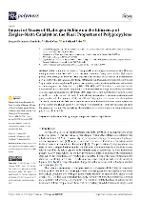Abstract
Sulfur compounds are removed from propylene through purification processes. However,
these processes are not 100% effective, so low concentrations of compounds such as H2S may be
present in polymer-grade propylene. This article studies the effects of H2S content on polypropylene
polymerization through the controlled dosage of this compound with concentrations between 0.07 and
5 ppm and its monitoring during the process to determine possible reaction mechanisms and evaluate
variations in properties of the material by TGA, FTIR, MFI, and XDR analysis. It was found that the
fluidity index increases directly proportional to the concentration of H2S. In addition, the thermo oxidative degradation is explained by means of the proposed reaction mechanisms of the active center
of the Ziegler–Natta catalyst with the H2S molecule and the formation of substances with functional
groups such as alcohol, ketones, aldehydes, CO, and CO2 by the oxidation of radical complexes.
This study shows for the first time a reaction mechanism between the active center formed for
polymerization and H2S, in addition to showing how trace impurities in the raw materials can affect
the process, highlighting the importance of optimizing the processes of removal and purification of
polymer-grade materials














